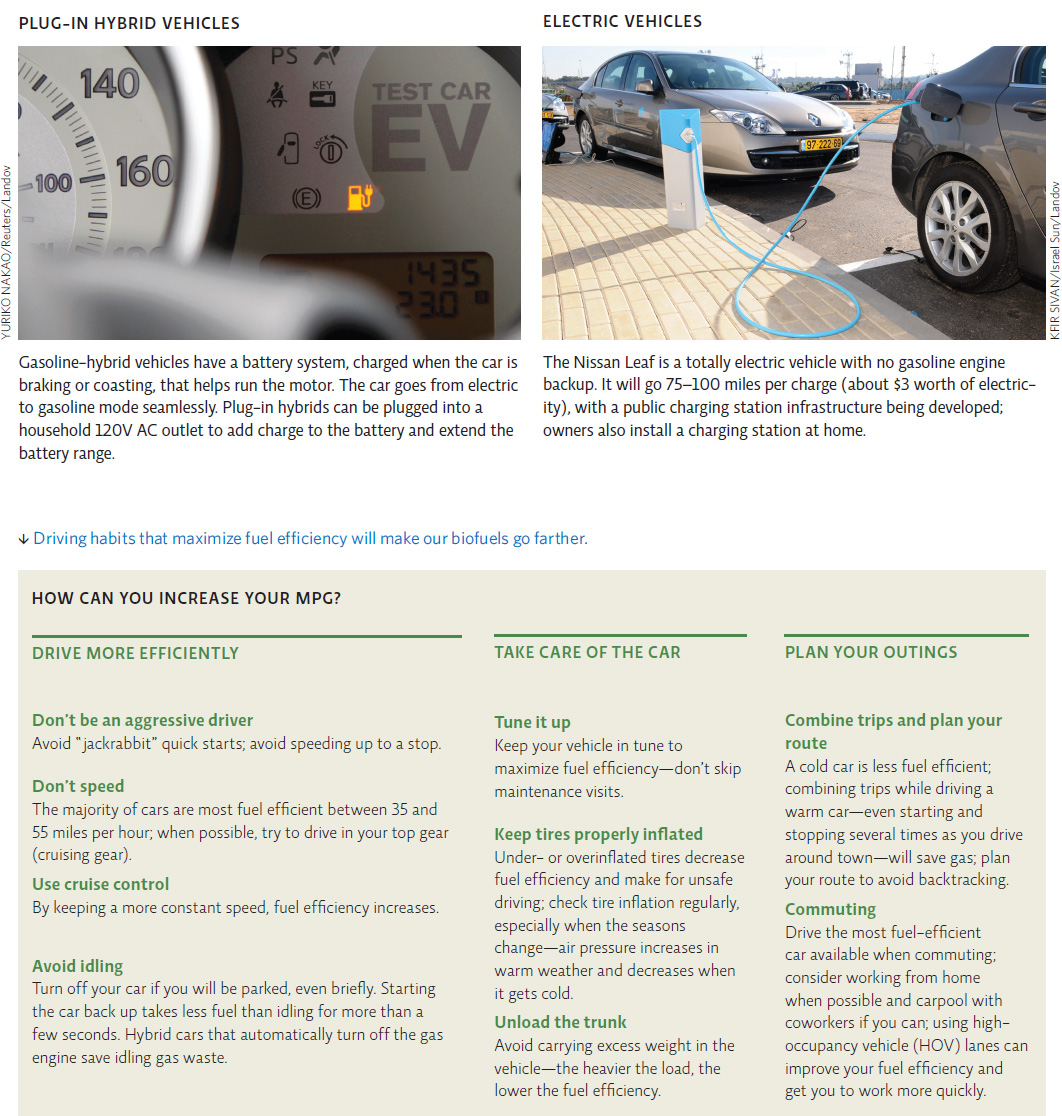Multiple solutions will be needed to help replace fossil fuels.
Like all other strategies to replace fossil fuels, biofuels will never have just one golden-ticket winner. Instead, a patchwork of feedstocks grown and processed across the country will help provide our fuel. The good news is that we have a wide variety of options, which enables us to focus on the types of biofuels that work best for different needs or in different regions.
Whatever the future, one thing is sure: To be truly environmentally friendly, we may simply have to stop using so much fuel. This means increasing energy efficiency to decrease waste, and it also means basic conservation—simply using less.
The energy efficiency of vehicles can be improved with lighter materials, more aerodynamic shapes, more energy-efficient engines, and hybrid technologies that pair electric motors with internal combustion engines. Completely electric vehicles would lessen the demand for liquid fuels. Drivers can also increase the fuel efficiency of whatever vehicle they drive by adopting better driving habits and, of course, by driving less overall. INFOGRAPHIC 32.6
Choosing the vehicle that meets your needs but that is also fuel efficient is an important part of the solution to our energy problems. Go to www.fueleconomy.gov to compare different makes and models of cars for fuel efficiency. This can also save you money: A car that is 10 MPG more efficient than another will save the driver almost $1,000 in fuel costs per year (assuming 15,000 miles driven per year with gasoline at $3.65/gal). All the major (and some smaller) car companies have hybrid and/or electric vehicles on the road or in planning. Though hybrids are generally more fuel efficient than other cars, many traditional (and less expensive) models get 30 to 40 MPG.

YURIKO NAKAO/Reuters/Landov
KFIR SIVAN/Israel Sun/Landov

Considering your own needs, financial resources, and personal preferences, what type of car would you most likely purchase if you wanted to decrease your use of gasoline?
Answers will vary – those with more funds might opt for a hybrid or electric vehicle (but electric vehicles are only good if you have relatively short daily commutes). Those who need a less expensive car may opt for a fuel efficient conventional car. Those who need a larger or more powerful vehicle will have fewer choices but some models of larger cars and truck are more fuel efficient than others so the choice of the right vehicle can still make a difference.
In 2007, Congress passed the Energy Independence and Security Act, which requires the United States to produce 36 billion gallons of renewable and alternative fuels per year by 2022 (up from 11 billion gallons produced in 2009)—equivalent to about one-quarter of the entire country’s yearly use of gasoline.
We are behind schedule. The economic downturn and obstacles to scaling up cellulosic ethanol have stalled progress in recent years. The goal for 2010 was 250 million gallons of cellulosic ethanol; that year, we produced only 25 million gallons—off by a factor of 10. Uncertainties about whether the EPA will reduce its target for biofuel production or whether tax credits and subsidies will remain available make cellulosic ethanol a risky investment, and many venture capitalists have pulled out of projects.
Even so, biofuel projects are moving ahead. Many U.S. states offer rebates or tax exemptions on fuels for commercial vehicles that operate on biodiesel blends or E-85 fuels, and financial incentives like tax credits or grants are offered to biodiesel producers or distributors. In August 2011, the U.S. federal government launched a $510 million program, in the form of matching funds, to help finance biofuel projects directed toward military transportation applications.
KEY CONCEPT 32.7
No single fuel will replace fossil fuels for mobile sources (vehicles), but a wide variety of options are available, and more are on the horizon. Reducing our needs via conservation and energy efficiency will be an important part of the solution.
Biofuels are also growing in popularity around the world. Brazil, a world leader in ethanol biofuel, has no light vehicles that run on 100% gasoline, and Brazilian car manufacturers have developed vehicles that run on ethanol blends or 100% ethanol. China and India have national policies mandating the increase of the ethanol component of gasoline. In addition, China, India, and other developing countries are supporting biodiesel production from locally grown crops such as the succulent plant jatropha. Meanwhile, China is pursuing the development of technologies to produce biofuels from municipal garbage. Smaller-scale programs are also under way in many nations around the world.